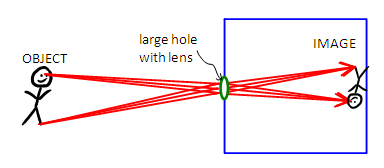Cameras
Let's say you want to record a picture of your friend, and you have a large sheet of old-fashioned photographic film. You take the film out of its box and hold it up, facing towards your friend. You get the film developed, but alas there is no image on the film. Why didn't that work?
The problem is that every point on your friend is sending light in all directions. Light rays naturally diverge from their source. Light from the tip of her nose is hitting every spot on the film, and light from the top of her head hits everywhere on the film, too. You can think of it as a very blurry picture! In order to make a good image, however, we want the light rays from one spot on your friend to hit one spot on the film. There are several ways to accomplish this.
to do as you read
This simplest way is to make a pinhole camera. Put the film inside a light-proof box, with only a small hole in the wall opposite the film. Light from your friend's left eye still goes in all directions, but only the light rays that hit the pinhole make it to the film. Light from the eye hits one spot on the film, and light from her foot hits a different spot. (See diagram below, top half.) Each spot on the film is a little larger than the size of the pinhole (the rays are still diverging, after all) but if the pinhole is small, the picture will be sharp.

Pinhole cameras are not very practical. The pinhole doesn't let in much light, so the exposure time (the time the shutter is open) has to be long. This can be used to artistic effect: because the exposure time can be very long — minutes, even — any objects that are moving will be blurred into nonexistence in the photograph. You can take a picture of a street scene with cars and people, and the final image will appear as a deserted street.
You can let more light in by making the hole larger, but then the picture gets blurry. (See diagram above, bottom half.) We'll get around this by using a converging lens, which will take the diverging rays from the object, and make them converge and come to a focus, where we will place the film. See diagram below.

If the object moves closer to, or further from the lens, then the location of the in-focus image will change. For the picture to be sharply in focus, the position of the lens or film must be adjusted to put the film at the place where the rays cross. In older, pre-electronic cameras, the photographer must focus by moving the lens by hand; electronic cameras have motors that move the lens.